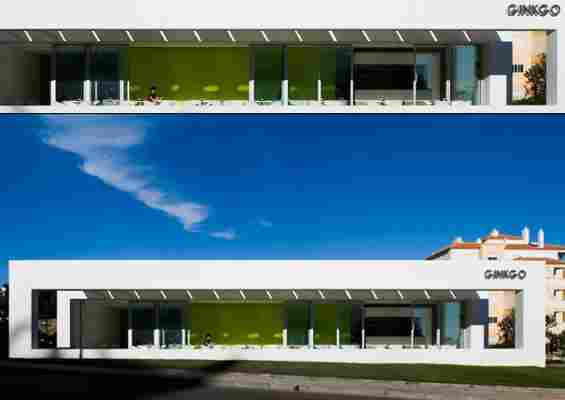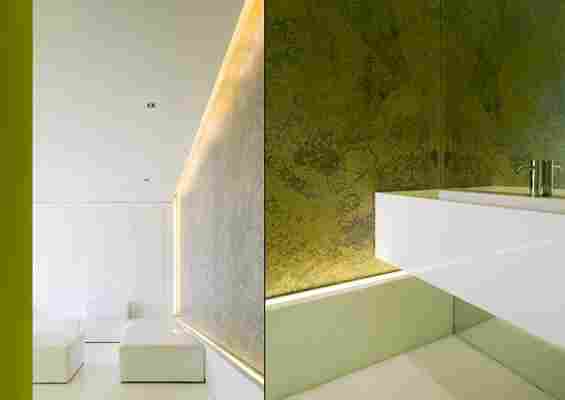Those who stay in apartments crave for spacious bungalows and those who live in landscaped acres dread the maintenance! So what really is the ideal size for a home? The multi-storey high-rises offer many titillating features and let’s not even get into their crazy architectural style. Offices, museums, theaters even live gardens in the middle of the 100th floor; we can expect all of this from modern architects. Till you find your ideal space to call home, office, whatever….here’s a recap of Fifteen Visually Stunning Architectural Delights for the future! 15) New Orleans Arcology Habitat or NOAH by E. Kevin Schopfer AIA, RIBA & Tangram 3DS; Kittery, ME
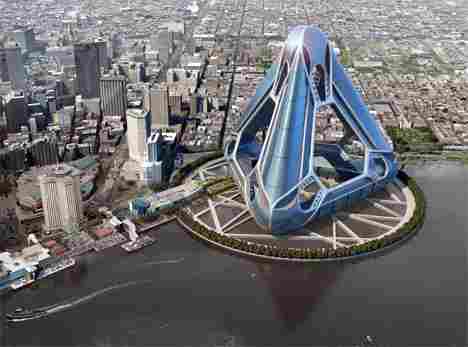
NOAH proposes to be a habitat for 40,000 residents who can benefit from the planned residential units, school system, commercial, retail, hotels, casinos, parking, and public works facilities. Its triangle shape is most captivating and literally stands out on the waterfront. Quite a design challenge actually, this place needs to overcome both the physical and psychological damages of recurring severe weather patterns.
14) Eko by 10 Raisons Architects
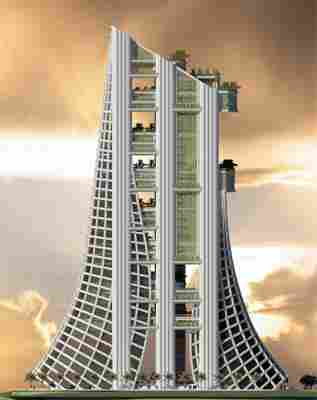
Critics may pan it for getting inspired by the romantic Eiffel Tower, but the giant Eko looks like a tower with webs on the side. It boasts of 24 floors, 8500 Square meters of Nano Solar, 350 palms, a bar, a library and a big exhibition hall and is proposed as a futuristic housing high-rise for Zaabeel Park, City Center in Dubai.
13) Campus Center for Miami Dade College by Oppenheim Architects
If Polo is the mint with a hole, then the Miami Dade College is a Super Building Campus Center for Miami Dade College is the architectural version of it. The high rise combines apartments, offices, educational facilities, and a lot of space for art exhibition. It’s supposed to get completed in the next two years time, can anyone in Miami confirm this?
12) Guggenheim Hermitage Museum by Zaha Hadid
Conceptualized as a floating structure above the fluid landscape in Vilnius, Lithuania, the Guggenheim Hermitage Museum is the renowned firm Zaha Hadid Architects’ brainchild. Featuring glossy, metallic surfaces, this building is a visual treat for true connoisseurs.
11) Klein Bottle House by McBride Charles Ryan
The “Klein Bottle” is a non-orientable surface, i a surface (a two-dimensionaltopological space) with no distinction between the “inside” and “outside” surfaces. By constantly challenging our sense of perception, depth, linear orientation, interior/exterior space and pretty much any notion of what a dwelling should look like, the architects have successfully created a space that is surprisingly inviting and warm.
10) Torre Bicentenario by Office for Metropolitan Architecture (OMA)
Resembling 2 inverted pyramids bridged by a lobby where shuttles and elevators pass thru, the Torre Bicentenario is slated become the tallest building in Latin America. Completion is scheduled for this year to coincide with the 200th anniversary of Mexico’s Independence. Two voids penetrate the building at its widest point providing ventilation and natural light.
9) Dancing Towers by Zaha Hadid
With the spate of earthquakes hitting our foundations this year, the thought of dancing towers is not so appealing. Keeping aside such fears, these three towers are inter-twinned to share programmatic elements and rotate to maximize the views from the site towards the creek and neighboring developments. Another visual treat that defies common norms.
8 ) Landmark Building of Szervita Square by Zaha Hadid
Another Zaha Hadid gem that looks to mesmerize us with soft curves and defining structure.
7) The Cube at Dubai Sports City
When we see ambitious projects like The Palm and The Cube here, we can totally understand why Dubai went under the real-estate scare recently. Is proposed to be a five-star condo hotel, an eye catcher at the Dubai Sports City.
6) Seoul Commune 2026 by Mass Studies
When you want to cite an example of how to marry nature with tall buildings, please refer the Seoul Commune 2026. It’s the case where you can negate the concrete jungle effect with a little help from Mother Nature!
5) Expocenter Project by Zaha Hadid
Yes Zaha Hadid is a staple at YD, what can we say…phenomenal works do warrant appreciation and here’s another feather in the Hadid cap! The Expocenter Project offers Moscow city a new exposition venue, hotel, and residential development. Tall and long beautifully combined.
4) Millennium Tower World Business Center (WBCB) in Busan by Asymptote
Asymptote won the contract to build this tower based on its ground breaking design of three separate tapered towers rising out of a robust and powerful base. This one can be filed under sculptural beauty.
3) Trump International Hotel and Tower Dubai by Nakheel & Atkins
With Trump attached to any property you can expect sheer extravaganza and nothing else! Likewise this 60-storey building features two asymmetrical halves forming a gateway to the Palm Islands of Jumeirah. The stainless steel, glass and stone faded arch-like structure includes a 300-room five-star hotel, 400 residential apartments, boutique offices, retail, gym and spa, restaurants and of course, access to private beaches.
2) Gateway Building for Ras Al-Khaimah by Snohetta
Like an oasis in the hot arid desert, the Gateway Building for Ras Al-Khaimah greets you with the magic and charm of the Arabs. A gateway to the city Ras Al-Khaimah, expect a Congress Center, Exhibition Halls, Shopping Center, and elite hotels in this complex.
1) Abu Dhabi Performing Arts Centre by Zaha Hadid
Zaha Hadid Architects does it once again with the spectacular Abu Dhabi Performing Arts Center. Fluid lines that transcend and meander through spaces to actually construct a Performing Arts Center! Its been described as a sculptural form that emerges from a linear intersection of pedestrian paths within the cultural district, gradually developing into a growing organism that sprouts a network of successive branches.
Twenty-seven Captivating Skyscrapers From The Future
It takes a lot of courage to imagine building a buoyant skyscraper that rebuilds the arctic ice caps or a structure that shifts your living-scape from the ground to the skies, literally. The future of our living quarters depends a lot upon how we treat our resources today. Going by these Twenty-seven Captivating Skyscrapers (3 award-winning and 24 honorable mentions), looks like we still need to do a lot for our mother earth. Have a look at some really creative, ingenious and dynamic vertical communities, seen through the eyes of eVolo â¦
Polar Umbrella by Derek Pirozzi
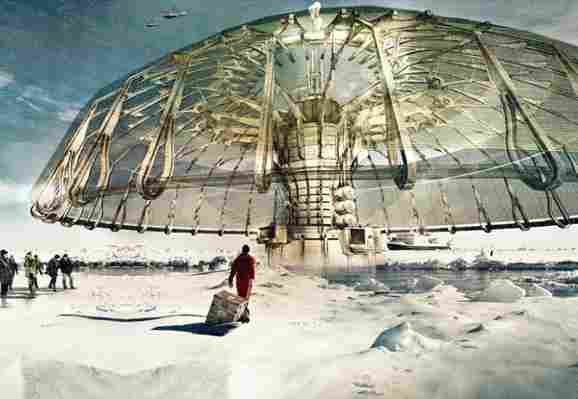
The Polar Umbrellaâs buoyant super-structure becomes a statement for the prevention of future depletion of our protective arctic region. Through its desalinization and power facilities, this arctic skyscraper becomes a floating metropolis equipped with NOAA (National Oceanic and Atmospheric Administration) research laboratories, renewable power stations, dormitory-style housing units, eco-tourist attractions, and ecological habitats for wildlife. A series of these structures would be strategically located in the most affected areas.
The Phobia Skyscraper by Darius Maïkoff & Elodie Godo
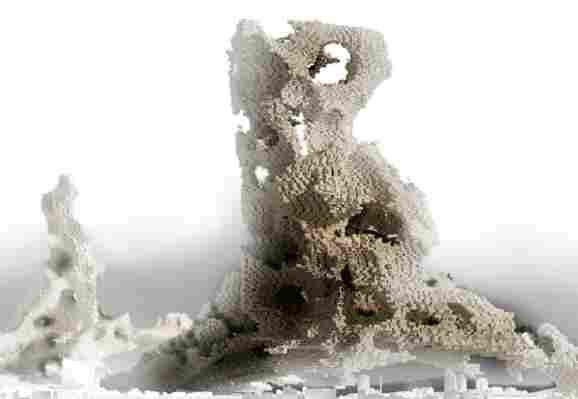
The Phobia Skyscraper is a new form of modular suburban residential development for Paris, France. It is located over the âPetite Ceintureâ, a former industrial site with excellent views of the city and an extensive transportation network.
Light Park Floating Skyscraper by Ting Xu & Yiming Chen
The Light Park stays afloat thanks to a large, mushroom cap-like helium-filled balloon at its top, and solar-powered propellers directly below. Programmatic platforms that host parks, sports fields, green houses, restaurants, and other uses are suspended from the top of the structure by reinforced steel cables; the platforms fan in different directions around the spherical vessel to balance its weight. These slabs are also staggered to allow for maximum exposure to sunlight on each level.
The Soundscraper by Julien Bourgeois, Olivier Colliez, Savinien de Pizzol, Cédric Dounval & Romain Grouselle
The Soundscraper takes advantage of city noise pollution by capturing airborne sound and converting it into usable energy. It is located next to main transport infrastructures, mostly outside city centers where noise pollution is at its maximum. Motorway junction, railway hub represent no manâs land in the urban territory and areas of greatest efficiency to produce energy.
The Stratosphere by Mingxuan Dong, Yuchen Xiang, Aiwen Xie, Xu Han
As technological innovative and higher latest skyscrapers can be, they still need to rely on the support to the ground. So a higher height usually means more unstableness as well as weaker capacity to resist disasters. The project proposes a mega hex grid that evolves around the earth circumference at a stratosphere height, the principle that support this hypothesis is that it seems to be that in a building the larger the span is, the scale and the unstableness will proportionally increase.
PH Conditioner Skyscraper by Hao Tian, Huang Haiyang & Shi Jianwei
Produced by the fossil fuel used in abundance, as well as the heavy traffic and industrial production, the SO2&NOx drives the PH value of atmosphere under 5.6. Gradually precipitating to the surface of the earth, these acidic materials have caused great harm to plant, architecture and human beings. The project aim to use a gentle way to manage Acid Deposition and eventually turn pollutants into available resources (reclaimed water & chemical fertilizer) for the region of Chongqing.
The Skinscape by Woongyeun Park, Jaegeun Lim, Haejun Jung & Karam Kim
The Skinscape project was inspired from the idea that the natural environment modifies architecture as time passes by and in some instances nature even reclaims it. For example, Banyan trees now cover the Angkor Wat Temple in Cambodia built in 12th century. Experts have decided not to remove the trees because they now serve as part of the structural system â building and nature have become one.
Nomad by Antonio Ares Sainz, Joaquin Rodriguez Nuñez, Konstantino Tousidonis Rial
The Project Nomad’s goal is to change the atmospheric and soil chemistry of Mars to make it hospitable for human colonization.
VolcanElectric Mask by Jing Hao, Zhanou Zhang, Xingyue Chen, Jiangyue Han & Shuo Zhou
The designers of the VolcanElectric Mask propose constructing an industrial structure over a volcano that can collect tephra during an eruption, keeping it out of the skies and away from cities and villages below, and also harness the power from the volcanoâs heat in calm periods to provide clean electric power to surrounding areas.
Symbiocity by Khem Aikwanich & Nigel Westbrook
The Symbiocity project rethinks the way prisons are built and operated in an effort to better criminal justice and rehabilitation systems.
Charybdis by Nam Il Joe, Laura E. Lo & Mark T. Nicol
By extending the ethos of reuse to the aqueous environment, Charybdis reconsiders the plastic detritus in the worldâs oceans as building material.
Kinetic Islands by Park Sung-Hee & Na Hye Yeon
Kinetic Islands address the Great Pacific Garbage Patch problem and propose a solution for disposal huge-amount of plastic and garbage patches in North-east Pacific Ocean, and take advantage of them as construction elements for a futuristic floating city.
Urban Earth Worm Skyscraper by Lee Seungsoo
The Urban Earth Worm skyscraper uses one of the basest of creatures as its inspiration. Just as earthworms clean the soil and solve pollution problems, promulgating life in thriving ecosystems, this skyscraper will clean air and soil pollution in cities and also feed cities â literally.
Zero by Ekkaphon Puekpaiboon
Zero is a radical skyscraper, designed to ensure mankindâs survival after global devastation. Like an emergency toolbox, it will be the starting point to the reestablish social order through digital communication and information exchange.
Scraper by Jong Hyuk Lim, Seung Jun Park, Sung Wha Na, Jae Chung ko, Ho Young Yeo & Gyoeng Hwan Kim
The massive amount of waste and debris accumulated in the Pacific Ocean is known as the Pacific Garbage Patch. The Scraper is a floating building designed to collect and compact the garbage into cubes with the use of automated robots.
Big Wood by Michael Charters
Big Wood is a prototype on mass timber construction that offers the possibility to build more responsibly while actively sequestering pollutants from our cities. Sited in Chicago; âBig Woodâ aims to write a new chapter in high-rise construction.
Sea-Ty by Shinypark, Liu Tang & Lyo Heng Liu
Building an underwater city is the main goal of this project that responds to the sea level rise in the upcoming decades. The US National Research Council estimates that in this century alone, the sea level will rise between 50 and 200 centimeters â leaving some existing cities underwater.
Moses by Milos Vlastic, Vuk Djordjevic, Milos Jovanovic & Darki Markovic
Moses is a decentralized, self-sustaining city unit, populated by approximately 25,000 inhabitants, which offers the transition of men from land to sea, so that the land could be used for food production and the Earth could start its process of self-regeneration from the negative human impact. It functions independently as a city-unit, as well as a cluster of units, which share information, energy, and goods.
Sphera by Santi Musmeci & Sebastiano Maccarrone
Sphera is a new type of living environment, where the citizens of the world will live during the âearthâs regenerationâ, by using innovative and sustainable energies. At the same time, the purpose of Sphera is to build an entirely new civilization, where people will try to redesign their culture and generate a sustainable society by creating a global-resource based economy that enables all people to reach their highest potential, a society that protects and preserves its environment.
Aeroponic by Jin Ho Kim
This project proposes the creation of decentralized aeroponic vertical farmlands that will be able to provide enough rice for future generations. The basic structure consists of an array of bamboo parallelograms that create stepping terraces of rice fields.
Quantum Skyscraper by Ivan Maltsev & Artem Melnik
The form of a skyscraper is a growing crystal â a structure characterized by the inconstancy and regularity of its elements. The height of the units ranges from 130 to 180 m. At the full height, in the center of Multipurpose Research Complex (MNC), is a static rod â a quantum safe energy source, which will produce energy in the required quantity. The center of quantum computing, greenhouses, walking tracks and, aeration blocks are placed in immediate proximity.
Water Re-balance Tower by Zhang Zhiyang & Liu Chunyao
By building towers that can collect and purify rainwater and also purify the water from the river, several advantageous things occur: clean, drinkable water is readily available for the city; rising river levels are mitigated before flooding occurs; and clean water can also be pumped back under ground to fix the sinking subsidence problem the city is experiencing.
Crater Scraper by Xiaomia Xiao, Lixiang Miao, Xinmin Li & Minzhao Guo
The Crater Scraper project is an imagined solution for the healing of the Earthâs surface as the planet suffers the impact of major asteroid strikes. Asteroid craters could be filled in with built settlements, holding communities of different sizes (depending on the size of the crater).
Repair Goaf by Liangpeng Chen, Yating Chen, Lida Huang, Gaoyan Wu & Lin Yuan
The project proposes to reuse the goaf and part of the pipelines on the working platforms. The vertical pipelines will work as the chief transportation system. The main volumes are deposited in the site.
Mist Tree by Yeonkyu Park, Kwon Han, Hyeyeon Kwon & Hojeong Lim
Mist-Tree is a skyscraper which can bring new life to Atacama, Chile. It proposes a simple solution to end the drought coming from the high ranges of the mountains. The skyscraper penetrates through the Andes mountain range and captures fog from the sky of the Pacific Ocean.
Promised Land by Chen Yao, Xiao Yunfeng, Li Xiaodi, Xie Rui & Yin Xiaoxiang
The Promised Land is conceived as âhumansâ final homeland, a self-sustainable city on submerged places, shape as massive cross rising over the water level. The building works as a modular self-assembly system. Prefabricated girders and columns made of reinforced concrete are fixed on the ground as foundation, and then prefabricated floors are placed in order to sustain the different programmatic modules.
Ring of Mars by Mamon Alexander & Tyutyunnik Artem
The Ring of Mars is a closed self-sufficient off-line mega-structure, which contains all functions for comfortable existence and development of all life forms.The ring is designed on the model of linear cities, a circular system for comfortable connection of all parts of the structure as single agglomerate.
Poolside Roadside Lounge
So you’ve got an aparthotel (apartment/hotel) somewhere and you want to add a poolside bar between the ol’ water hole and the road. But there’s only a small strip! What do you do? You use the ENTIRE SPACE and not only make a bar, but a bar and lounge, and not just for the aparthotel, but for the entire public.
And make it hecka sleek.
Visually clean and comfortable. The “esplanade”, aka the big open walking area along the front is framed by a wonderfully gigantic window. Fresh inside and out. Prefabricated concrete walls, raw to contrast the cleanliness of the rest of the space.
And why the name Ginkgo? In honor of the 30 million year old species of trees, the Ginkgo Biloba. To instill in this design a sense of longevity.
Designer: Tiago Miguel A.M.S. Rosado
